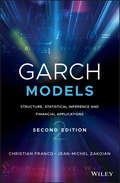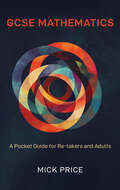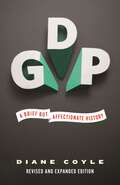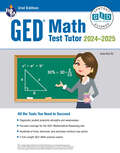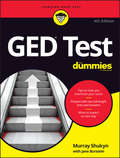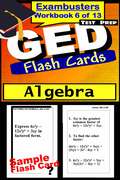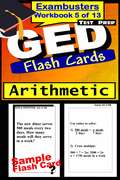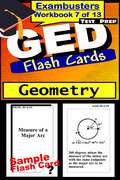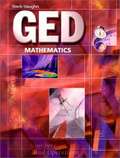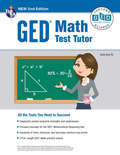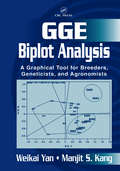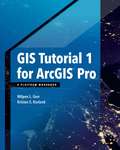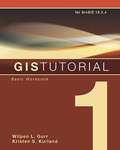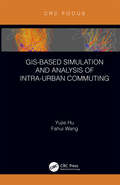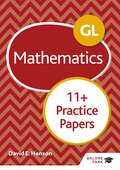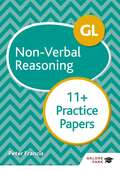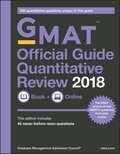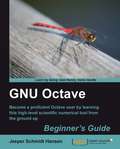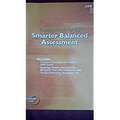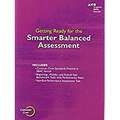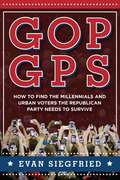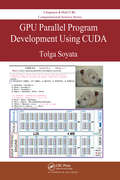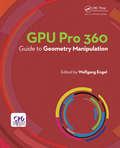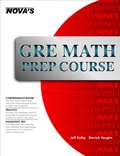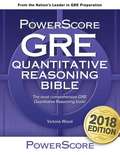- Table View
- List View
GARCH Models: Structure, Statistical Inference and Financial Applications
by Jean-Michel Zakoian Christian FrancqProvides a comprehensive and updated study of GARCH models and their applications in finance, covering new developments in the discipline This book provides a comprehensive and systematic approach to understanding GARCH time series models and their applications whilst presenting the most advanced results concerning the theory and practical aspects of GARCH. The probability structure of standard GARCH models is studied in detail as well as statistical inference such as identification, estimation, and tests. The book also provides new coverage of several extensions such as multivariate models, looks at financial applications, and explores the very validation of the models used. GARCH Models: Structure, Statistical Inference and Financial Applications, 2nd Edition features a new chapter on Parameter-Driven Volatility Models, which covers Stochastic Volatility Models and Markov Switching Volatility Models. A second new chapter titled Alternative Models for the Conditional Variance contains a section on Stochastic Recurrence Equations and additional material on EGARCH, Log-GARCH, GAS, MIDAS, and intraday volatility models, among others. The book is also updated with a more complete discussion of multivariate GARCH; a new section on Cholesky GARCH; a larger emphasis on the inference of multivariate GARCH models; a new set of corrected problems available online; and an up-to-date list of references. Features up-to-date coverage of the current research in the probability, statistics, and econometric theory of GARCH models Covers significant developments in the field, especially in multivariate models Contains completely renewed chapters with new topics and results Handles both theoretical and applied aspects Applies to researchers in different fields (time series, econometrics, finance) Includes numerous illustrations and applications to real financial series Presents a large collection of exercises with corrections Supplemented by a supporting website featuring R codes, Fortran programs, data sets and Problems with corrections GARCH Models, 2nd Edition is an authoritative, state-of-the-art reference that is ideal for graduate students, researchers, and practitioners in business and finance seeking to broaden their skills of understanding of econometric time series models.
GCSE Mathematics - A Pocket Guide for Re-takers and Adults
by Mick PriceAs its title suggests, this book by been devised by author Mick Price as an essential guide for those revisiting Mathematics at GCSE level. Crafted from years of experience and class-tested materials, it serves as a unique revision tool, tailored for both FE college students and adults seeking to improve their previous grades or refresh long-forgotten knowledge. Stripping back the complexities of mathematics, this book focuses on the fundamentals needed to achieve a grade 4, without overwhelming its readers with the entirety of KS4 content. GCSE Mathematics promises accessibility and convenience, making it an indispensable companion for both classroom learning and self-study. Inside, you’ll find a blend of theoretical essentials, practical real-life examples, and exercises designed for both younger and more mature learners, all presented in a straightforward, uncondescending manner. GCSE Mathematics is not just a book: it’s a tool for success, always within reach.
GDP: A Brief but Affectionate History - Revised and expanded Edition
by Diane CoyleHow GDP came to rule our lives—and why it needs to changeWhy did the size of the U.S. economy increase by 3 percent on one day in mid-2013—or Ghana's balloon by 60 percent overnight in 2010? Why did the U.K. financial industry show its fastest expansion ever at the end of 2008—just as the world’s financial system went into meltdown? And why was Greece’s chief statistician charged with treason in 2013 for apparently doing nothing more than trying to accurately report the size of his country’s economy? The answers to all these questions lie in the way we define and measure national economies around the world: Gross Domestic Product. This entertaining and informative book tells the story of GDP, making sense of a statistic that appears constantly in the news, business, and politics, and that seems to rule our lives—but that hardly anyone actually understands.Diane Coyle traces the history of this artificial, abstract, complex, but exceedingly important statistic from its eighteenth- and nineteenth-century precursors through its invention in the 1940s and its postwar golden age, and then through the Great Crash up to today. The reader learns why this standard measure of the size of a country’s economy was invented, how it has changed over the decades, and what its strengths and weaknesses are. The book explains why even small changes in GDP can decide elections, influence major political decisions, and determine whether countries can keep borrowing or be thrown into recession. The book ends by making the case that GDP was a good measure for the twentieth century but is increasingly inappropriate for a twenty-first-century economy driven by innovation, services, and intangible goods.
GED Math Test Tutor, For the 2024-2025 GED Test: Certified GED Content-Aligned Prep (GED® Test Preparation)
by Ms. Sandra RushIf you’re concerned about your math score on the GED test, you need REA’s GED Math Test Tutor!Certified by GED Testing Service to be 100% aligned and up-to-date for today’s GED testWinner of the ProCert Excellence in Education Award for Best-in-Class GED PrepREA’s GED Math Test Tutor (2nd Edition), now available as a fully accessible, reflowable EPUB edition optimized to be read on a wide range of devices. Test-takers report that the Mathematical Reasoning test is the toughest of all the GED subjects. That’s why REA offers the most complete guide to success on the GED Math test. Here’s what’s included: Expert review of every concept covered on the test – REA’s targeted subject review covers all the math topics you’ll see on the exam, including fractions, decimals, percentages, algebra, polynomials, scientific notation, and more. Know your way around the TI-30XS MultiView calculator – A step-by-step tutorial on the official GED calculator gets you up and running in no time. Helpful hints you need to know – Hundreds of hints, shortcuts, and exercises reinforce key math points, including the secrets of rounding, calculating with fractions, how to tell the difference between domain and range, and much more! Diagnostic pretest and two full-length practice tests – A diagnostic pretest with comprehensive feedback helps you pinpoint your strengths and weaknesses. Two full-length practice tests feature every type of question and skill tested on the GED Mathematical Reasoning test. Each practice test comes with detailed solutions to help you pinpoint where you need more review.Get on your way with REA, a trusted GED Publisher Partner recognized by GED Testing Service for developing content that is 100% aligned with the GED test.
GED Test For Dummies
by Jane R. Burstein Murray ShukynScore high on the GED Test In today's job environment, it's usually the better-educated person who gets the position, promotion, or raise. <P><P>Scoring high on the GED Test can give you an edge over the competition—whether it's to get a brand-new job or advance in the one you already have. If you're preparing for the exam and want to increase your odds of scoring higher, GED Test For Dummies gets you up and running with everything you need to know for test day. Inside, you'll find valuable, easy-to-digest information for navigating your way through tests on Language Arts, Social Studies, Mathematical Reasoning, and Science. <P><P>Whether you're looking to perfect your grammar and punctuation skills, put the social in your studies, take the fear out of math and science, get familiar with different types of fiction and nonfiction passages, or answer every multiple-choice question with confidence, <P><P>GED Test For Dummies makes it not only possible, but easy for you to score high on this life-changing exam. <br>Fully updated to reflect the latest version of the GED test Includes two full-length practice tests with answers and detailed explanations <br>Provides vital information and test-taking tips to help maximize your score Includes special considerations for those whose first language isn't English <br> Feel good about yourself knowing that you accomplished something amazing. Get GED Test For Dummies and put yourself on the road to greater success.
GED Test Prep Flash Cards: Algebra (Exambusters GED Workbook #6 of 13)
by Ace Inc.<P><P><i>Advisory: Bookshare has learned that this book offers only partial accessibility. We have kept it in the collection because it is useful for some of our members. Benetech is actively working on projects to improve accessibility issues such as these.</i><P><P> 450 questions. Topics: Sets, Variables, Exponents, Polynomials, Word Problems, Radicals, Quadratic Equations, and more. <P><P> EXAMBUSTERS GED Prep Workbooks provide comprehensive, fundamental GED review--one fact at a time--to prepare students to take practice GED tests. Each GED study guide focuses on one specific subject area covered on the GED exam. From 300 to 600 questions and answers, each volume in the GED series is a quick and easy, focused read. Reviewing GED flash cards is the first step toward more confident GED preparation and ultimately, higher GED exam scores!
GED Test Prep Flash Cards: Arithmetic (Exambusters GED Workbook #5 of 13)
by Ace Inc.<P><P><i>Advisory: Bookshare has learned that this book offers only partial accessibility. We have kept it in the collection because it is useful for some of our members. Benetech is actively working on projects to improve accessibility issues such as these.</i><P><P> 600 questions. Topics: Fractions and Decimals, Multiplication Tables, Percents, Metric System, Square Roots and Powers, and more. <P><P> EXAMBUSTERS GED Prep Workbooks provide comprehensive, fundamental GED review--one fact at a time--to prepare students to take practice GED tests. Each GED study guide focuses on one specific subject area covered on the GED exam. From 300 to 600 questions and answers, each volume in the GED series is a quick and easy, focused read. Reviewing GED flash cards is the first step toward more confident GED preparation and ultimately, higher GED exam scores!
GED Test Prep Flash Cards: Geometry (Exambusters GED Workbook #7 of 13)
by Ace Inc.<P><P><i>Advisory: Bookshare has learned that this book offers only partial accessibility. We have kept it in the collection because it is useful for some of our members. Benetech is actively working on projects to improve accessibility issues such as these.</i><P><P> 450 questions. Topics: Triangles, Proofs, Perpendicular Lines, Parallel Lines, Quadrilaterals, Circles, Coordinate Geometry, and more. <P><P> EXAMBUSTERS GED Prep Workbooks provide comprehensive, fundamental GED review--one fact at a time--to prepare students to take practice GED tests. Each GED study guide focuses on one specific subject area covered on the GED exam. From 300 to 600 questions and answers, each volume in the GED series is a quick and easy, focused read. Reviewing GED flash cards is the first step toward more confident GED preparation and ultimately, higher GED exam scores!
GED: Mathematics
by Steck-VaughnThe GED Mathematics Test focuses on the practical use of basic arithmetic, algebra, and geometry. You will be tested on your understanding of how to solve a problem and your ability to do the math to find a solution.
GED® Math Test Tutor, 2nd Edition
by Sandra RushREA's GED® Math Test Tutor - Focus on the most challenging part of the GED® test! <P><P>Revised Second Edition <P><P>It's like having your own tutor… <P><P>Each year, test-takers report that the Mathematical Reasoning test is the toughest of all the GED® tests. <P><P>That's why REA offers the most complete guide to success on the GED® Math test. Written by Sandra Rush, a GED® Math tutor and test expert <P><P>- This revised second edition of our best-selling test prep is completely aligned with the content and format of the current GED® test. A comprehensive review covers all the mathematics topics tested on the exam, including fractions, decimals, percentages, algebra, polynomials, scientific notation, and more. Know your way around the TI-30XS MultiView™ calculator <P><P>- A step-by-step tutorial gets you up and running in no time. Helpful hints you need to know - Hundreds of hints, shortcuts, and exercises reinforce key math points, including secrets of rounding, calculating with fractions, knowing the difference between domain and range, a neat way to remember negative and absolute values, and much more!Diagnostic pretest and two full length practice tests <P><P>- A diagnostic pretest with comprehensive feedback helps you pinpoint your strengths and weaknesses. Two full-length practice tests feature every type of question (including drag-and-drop, hot-spot, and drop-down test items), subject area, and skill tested on the GED® Mathematical Reasoning test. Each practice test comes with detailed answer explanations to help you identify where you need extra review.If you're concerned about your math score on the GED®, you need REA's GED® Math Test Tutor!
GGE Biplot Analysis: A Graphical Tool for Breeders, Geneticists, and Agronomists
by Weikai Yan Manjit S. KangResearch data is expensive and precious, yet it is seldom fully utilized due to our ability of comprehension. Graphical display is desirable, if not absolutely necessary, for fully understanding large data sets with complex interconnectedness and interactions. The newly developed GGE biplot methodology is a superior approach to the graphical analys
GIS Tutorial 1 For ArcGIS Pro: A Platform Workbook (GIS Tutorials Series)
by Wilpen Gorr Kristen KurlandGIS Tutorial 1 for ArcGIS(R) Pro: A Platform Workbook is an introductory text for learning ArcGIS Pro, the premier professional desktop GIS application. In-depth exercises that use ArcGIS Pro, ArcGIS Online, and other ArcGIS apps feature the latest GIS technology to show readers how to make maps, how to create and analyze spatial data, and how to manage systems with GIS. <P><p>Incorporating proven teaching methods in detailed exercises, "Your Turn" sections, and expanded homework assignments, this book is suited to learning GIS in a classroom. Wilpen L. Gorr and Kristen S. Kurland have written the top-selling GIS Tutorial 1: Basic Workbook, GIS Tutorial for Health, and GIS Tutorial for Crime Analysis.
GIS Tutorial 1: Basic Workbook (10. 3 Edition) (GIS Tutorials Series)
by Wilpen L. Gorr Kristen S. KurlandUpdated for ArcGIS Desktop 10, GIS Tutorial 1: Basic Workbook provides effective GIS training in an easy-to-follow, step-by-step format. By combining ArcGIS tutorials with self-study exercises intended to gradually build upon basic skills, the GIS Tutorial 1 is fully adaptable to individual needs, as well as the classroom setting. The tutorial demonstrates a range of GIS functionality, from creating maps and collecting data to using geoprocessing tools and models as well as ArcGIS 3D Analyst and ArcGIS Spatial Analyst extensions for further analysis. GIS Tutorial 1 includes a data CD for working through the exercises and fully functioning 180-day trial DVD of ArcGIS Desktop10 software, making it the smart choice for GIS beginners.
GIS-Based Simulation and Analysis of Intra-Urban Commuting
by Yujie Hu Fahui WangCommuting, the daily link between residences and workplaces, sets up the complex interaction between the two most important land uses (residential and employment) in a city, and dictates the configuration of urban structure. In addition to prolonged time and stress for individual commuters on traffic, commuting comes with additional societal costs including elevated crash risks, worsening air quality, and louder traffic noise, etc. These issues are important to city planners, policy researchers, and decision makers. GIS-Based Simulation and Analysis of Intra-Urban Commuting, presents GIS-based simulation, optimization and statistical approaches to measure, map, analyze, and explain commuting patterns including commuting length and efficiency. Several GIS-automated easy-to-use tools will be available, along with sample data, for readers to download and apply to their own studies. This book recognizes that reporting errors from survey data and use of aggregated zonal data are two sources of bias in estimation of wasteful commuting, it studies the temporal trend of intraurban commuting pattern based on the most recent period newly-available 2006-2010, and it focuses on commuting, and especially wasteful commuting within US cities. It includes ready-to-download GIS-based simulation tools and sample data, and an explanation of optimization and statistical techniques of how to measure commuting, as well as presenting a methodology that can be applicable to other studies. This book is an invaluable resource for students, researchers, and practitioners in geography, urban planning, public policy, transportation engineering, and other related disciplines.
GL 11+ Mathematics Practice Papers
by David E HansonExam Board: ISEBLevel: 11 PlusSubject: MathsFirst Teaching: September 2015First Exam: Autumn 2016Brand new for 2016, these practice exam papers prepare children for the most challenging pre-tests and 11 plus independent school examinations. Nine levelled exam papers with a total of 184 questions are designed to test pupil's ability across all mathematical topics:- there are four training tests, which include some simpler questions and slower timing designed to develop confidence- four tests in the style of pre-tests, ISEB and short-format CEM in terms of difficulty, speed and question variation- one test in the style of the longer format GL/bespoke tests in multiple choice question formatThe papers will develop and perfect exam technique, and will teach pupils to improve their response rates with timed papers. Pupils will ...- become familiar with the way long-format 11 plus tests are presented- build exam-room confidence by practising with a variety of exam paper styles- work with the most challenging question setThe brand new 11 plus and pre-test range has been constructed to help pupils follow a three step revision journey ..Step 1) 11 Plus Maths Revision GuideStep 2) Practice Papers11 Plus Maths Practice Papers 111 Plus Maths Practice Papers 2Step 3) Workbooks10-Minute Maths Tests Workbook Age 8-10 10-Minute Maths Tests Workbook Age 9-11 Mental Arithmetic Workbook Age 8-10 Mental Arithmetic Workbook Age 9-11
GL 11+ Non-Verbal Reasoning Practice Papers: For 11+, Pre-test And Independent School Exams Including Cem, Gl And Iseb
by Peter FrancisThree practice exam papers to test pupils ahead of the GL 11+ Non-Verbal Reasoning test,including those taking bespoke tests created by GL for individual schools. The papers are designed to:- Develop and perfect exam technique for GL 11+ Non-Verbal Reasoning tests- Teach pupils to improve their response rates with timed papers- Identify weaker areas and improve results by studying the answers, which contain references to Galore Park's revision materials for guidance and useful tips- The resource also contains links to downloadable answer sheets so that the tests can be re-sat.These practice papers are part of Galore Park's 11+ revision series, which provides a three-step learning journey that teaches children the skills needed to pass rigorous school entrance exams.
GMAT Official Guide Quantitative Review 2018
by Graduate Management Admission CouncilThe GMAT Official Guide Quantitative Review provides targeted preparation for the mathematical portion of the GMAT exam. Designed by the Graduate Management Admission Council, this guide contains 300 real GMAT questions from past exams including 45 never-before-seen questions, plus the following features: <p><p> - An overview of the exam to help you get familiar with the content and format <p> - Review essential algebra, geometry, arithmetic, and word problems <p> - Detailed answer explanations that explain how the test maker thinks about a question <p> - Questions organized in order of difficulty from easiest to hardest <p> - Access to the same questions online at gmat.wiley.com, where you can build your own practice sets <p> Don’t waste time practicing on fake GMAT questions. Optimize your study time with the GMAT Official Guide 2018 Quantitative Review using real questions from actual past exams.
GNU Octave Beginner's Guide
by Jesper Schmidt HansenThis is a practical, step-by-step guide that will help you to quickly become a proficient Octave user. The book is packed with clear examples, screenshots, and code to carry out your data analysis without any problems.This book is intended for anyone interested in scientific computing and data analysis. The reader should have a good level of mathematics and a basic understanding of programming will be useful, although it is not a prerequisite.
GO Math!: Getting Ready for the Smarter Balanced Assessment (Grade #5)
by Houghton Mifflin HarcourtCommon Core Assessment consortia have developed assessments that contain item types beyond the traditional multiple-choice format. This allows for a more robust assessment of students' understanding of concepts. Common Core assessments will be administered via computers; and Getting Ready for the Smarter Balanced Assessment presents items in formats similar to what you will see on the tests.
GO Math!: Student Edition, Grade 3 (GO Math! Ser.)
by Houghton Mifflin Harcourt StaffCommon Core Assessment consortia have developed assessments that contain item types beyond the traditional multiple-choice format. This allows for a more robust assessment of students' understanding of concepts. Common Core assessments will be administered via computers; and Getting Ready for the Smarter Balanced Assessment presents items in formats similar to what you will see on the tests. The following information is provided to help familiarize you with these different types of items. Each item type is identified on pages (vii-viii). The examples will introduce you to the item types. The following explanations are provided to guide you in answering the questions. These pages describe the most common item types. You may find other types on some tests.
GOP GPS: How to Find the Millennials and Urban Voters the Republican Party Needs to Survive
by Evan Siegfried Robert A. GeorgeEditors’ Pick for the Conservative Book ClubA roadmap to the future for Republicans With each passing election cycle, Republicans face stiffer and stiffer odds for winning elections at all levels. They have long relied on a combination of Baby Boomers and rural voters to propel them to victory in races for office. However, both of these populations will decline in the future. At the same time, the ranks of millennials and urban voters have exploded. Millennials (now the largest generation in the United States) and urban residents (the growing majority of the population) are the two groups that are the key to the future?both for the United States and for any major political party. Unfortunately, the Republican Party has largely put off bringing these vital groups into the fold. In fact, it faces a real identity crisis with them. Mention the words ?GOP” or ?Republican” and they immediately react negatively. They see the party and its members as being out of touch and focused on the past. What possible reason should they have to vote for them, or even listen to their ideas?GOP GPS offers a roadmap for Republicans to win over these key groups, showing how to do so using conservative values and principles. It addresses a wide array of issues, including social justice, education, marriage equality, debt, and the family. It will challenge all and show that the Republican Party is not the caricature the Left or the media make it out to be.
GPU Parallel Program Development Using CUDA (Chapman & Hall/CRC Computational Science)
by Tolga SoyataGPU Parallel Program Development using CUDA teaches GPU programming by showing the differences among different families of GPUs. This approach prepares the reader for the next generation and future generations of GPUs. The book emphasizes concepts that will remain relevant for a long time, rather than concepts that are platform-specific. At the same time, the book also provides platform-dependent explanations that are as valuable as generalized GPU concepts. The book consists of three separate parts; it starts by explaining parallelism using CPU multi-threading in Part I. A few simple programs are used to demonstrate the concept of dividing a large task into multiple parallel sub-tasks and mapping them to CPU threads. Multiple ways of parallelizing the same task are analyzed and their pros/cons are studied in terms of both core and memory operation. Part II of the book introduces GPU massive parallelism. The same programs are parallelized on multiple Nvidia GPU platforms and the same performance analysis is repeated. Because the core and memory structures of CPUs and GPUs are different, the results differ in interesting ways. The end goal is to make programmers aware of all the good ideas, as well as the bad ideas, so readers can apply the good ideas and avoid the bad ideas in their own programs. Part III of the book provides pointer for readers who want to expand their horizons. It provides a brief introduction to popular CUDA libraries (such as cuBLAS, cuFFT, NPP, and Thrust),the OpenCL programming language, an overview of GPU programming using other programming languages and API libraries (such as Python, OpenCV, OpenGL, and Apple’s Swift and Metal,) and the deep learning library cuDNN.
GPU Pro 360 Guide to Geometry Manipulation
by Wolfgang EngelWolfgang Engel’s GPU Pro 360 Guide to Geometry Manipulation gathers all the cutting-edge information from his previous seven GPU Pro volumes into a convenient single source anthology that covers geometry manipulation in computer graphics. This volume is complete with 19 articles by leading programmers that focus on the ability of graphics processing units to process and generate geometry in exciting ways. GPU Pro 360 Guide to Geometry Manipulation is comprised of ready-to-use ideas and efficient procedures that can help solve many computer graphics programming challenges that may arise. <P><P> Key Features: <li> Presents tips and tricks on real-time rendering of special effects and visualization data on common consumer software platforms such as PCs, video consoles, mobile devices <li> Covers specific challenges involved in creating games on various platforms <li> Explores the latest developments in the rapidly evolving field of real-time rendering <li> Takes a practical approach that helps graphics programmers solve their daily challenges
GRE Math Prep Course
by Jeff Kolby Derrick VaughnEvery year, students pay $1,000 and more to test prep companies to prepare for the math section of the GRE. Now you can get the same preparation in a book. Although the GRE math section is difficult, it is very learnable. GRE Math Prep Course presents a thorough analysis of GRE math and introduces numerous analytic techniques that will help you immensely, not only on the GRE but in graduate school as well. Features: * Comprehensive Review: Twenty-three chapters provide complete review of GRE math. * Practice: Includes 164 examples and more than 600 exercises! Arranged from easy to medium to hard to very hard. * Diagnostic Test: The diagnostic test measures your strengths and weaknesses and directs you to areas you need to study more. * Duals: These are pairs of similar problems in which only one property is different. They illustrate the process of creating GRE questions. * If your target is a 700+ score, this is the book!
GRE Quantitative Reasoning Bible
by Victoria WoodThe purpose of this book is to provide you with a thorough review of tested math concepts and to teach you new strategies for approaching the Quantitative Reasoning section on the GRE.
